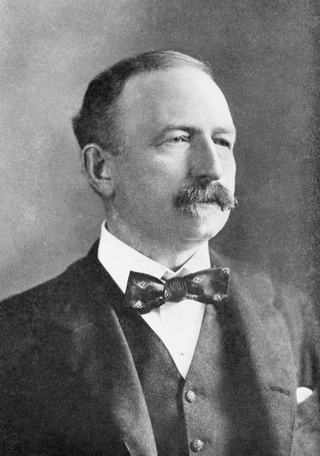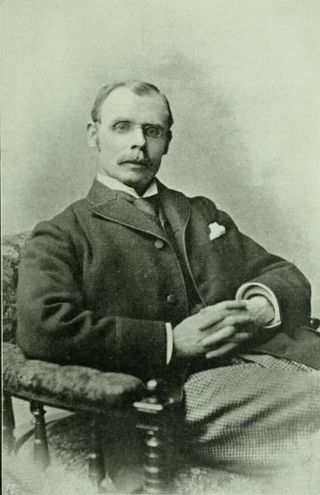
Earl Baldwin of Bewdley is a title in the Peerage of the United Kingdom. It was created in 1937 for the Conservative politician Stanley Baldwin, who had served as MP for Bewdley from 1908 to 1937 and was Prime Minister of the United Kingdom three times. He was made Viscount Corvedale, of Corvedale in the County of Salop, at the same time he was given the earldom.

Earl of Eldon, in the County Palatine of Durham, is a title in the Peerage of the United Kingdom. It was created in 1821 for the lawyer and politician John Scott, 1st Baron Eldon, Lord Chancellor from 1801 to 1806 and again from 1807 to 1827. He had already been created Baron Eldon, of Eldon in the County Palatine of Durham, in the Peerage of Great Britain in 1799, and was made Viscount Encombe, of Encombe in the County of Dorset, at the same time was given the earldom. His grandson, the second Earl, briefly represented Truro in the House of Commons.
Viscount Younger of Leckie, of Alloa in the County of Clackmannan, is a title in the Peerage of the United Kingdom. It was created on 20 February 1923 for the Unionist politician Sir George Younger, 1st Baronet. He had already been created a Baronet, of Leckie in the County of Clackmannan, in the Baronetage of the United Kingdom, on 12 July 1911. His grandson, the third Viscount, served as Lord Lieutenant of Stirlingshire from 1964 to 1979, whilst the third Viscount's brother was Labour MP Kenneth Younger. His son, the fourth Viscount, was a prominent Conservative politician. In 1992, five years before he succeeded his father, he was created a life peer as Baron Younger of Prestwick, of Ayr in the District of Kyle and Carrick. As of 2017, the titles are held by his son, the fifth Viscount, who succeeded in 2003 and joined the House of Lords as an elected hereditary peer in 2010.

Viscount Thurso, of Ulbster in the County of Caithness, is a title in the Peerage of the United Kingdom. It was created on 11 June 1952 for the Scottish Liberal politician and former Secretary of State for Air, Sir Archibald Sinclair, 4th Baronet. His son, the second Viscount, served as Lord Lieutenant of Caithness from 1973 to 1995.
Viscount Camrose, of Hackwood Park in the County of Hampshire, is a title in the Peerage of the United Kingdom. It was created on 20 January 1941 for the prominent newspaper magnate William Berry, 1st Baron Camrose. He had previously received the award of Baronet, of Long Cross in the County of Surrey, in the Baronetage of the United Kingdom, on 4 July 1921, and was created Baron Camrose, of Long Cross in the County of Surrey, on 19 June 1929, in the Peerage of the United Kingdom. His second son, the third Viscount, disclaimed the peerages in 1995 on succeeding his elder brother. However, he had already been created a life peer as Baron Hartwell, of Peterborough Court in the City of London, on 19 January 1968. On his death in 2001 the life peerage became extinct while he was succeeded in the other titles by his eldest son, the fourth Viscount. The first three Viscounts all headed The Daily Telegraph at one point, the first having purchased it from Harry Levy-Lawson, 1st Viscount Burnham, but in the 1980s they lost control to Conrad Black.

Baron Stanley of Alderley, in the County of Chester, is a title in the Peerage of the United Kingdom. It was created in 1839 for the politician and landowner Sir John Stanley, 7th Baronet.

Baron Faringdon, of Buscot Park in the County of Berkshire, is a title in the Peerage of the United Kingdom. It was created in 1916 for Sir Alexander Henderson, 1st Baronet, who had previously represented Stafford West and St George's, Hanover Square in the House of Commons as a Liberal Unionist. He had already been created a baronet in 1902. He was succeeded by his grandson, the second Baron. He was the son of the Hon. Harold Henderson, eldest son of the first Baron, who predeceased his father. Lord Faringdon was a member of the London County Council. As of 2017 the titles are held by his nephew, the third Baron, who succeeded in 1977. He is the son of the Hon. Michael Thomas Handerson, second son of the Hon. Harold Henderson.

Baron Glenarthur, of Carlung in the County of Ayr, is a title in the Peerage of the United Kingdom. It was created in 1918 for the Scottish businessman Sir Matthew Arthur, 1st Baronet. He had already been created a baronet, of Carlung in the County of Ayr, on 28 November 1902. The title of the barony was derived from the joining of his mother's maiden surname name of Glen and his patronymic Arthur.

Baron Londesborough, of Londesborough in the East Riding of the County of York, is a title in the Peerage of the United Kingdom. It was created in 1850 for the diplomat and Whig politician Lord Albert Denison. He was the third son of Henry Conyngham, 1st Marquess Conyngham, and his wife Elizabeth Denison. Born Albert Denison Conyngham, he assumed by royal licence the surname of Denison in lieu of Conyngham in 1849 on inheriting the vast fortune of his maternal uncle William Joseph Denison (1770–1849). Before his elevation to the peerage, Denison had represented Canterbury in Parliament. His eldest son, the second Baron, sat as a Liberal Member of Parliament for Beverley and Scarborough. In 1887 he was created Viscount Raincliffe, of Raincliffe in the North Riding of the County of York, and Earl of Londesborough, in the County of York. These titles were also in the Peerage of the United Kingdom. However, the viscountcy and earldom became extinct on the death of his grandson, the fourth Earl, in 1937.

Baron Northbrook, of Stratton in the County of Southampton, is a title in the Peerage of the United Kingdom. It was created in 1866 for the Liberal politician and former Chancellor of the Exchequer, Sir Francis Baring, 3rd Baronet. The holders of the barony represent the genealogically senior branch of the prominent Baring family. The name Northbrook is derived from a tithing of the local parish.

Baron Northbourne, of Betteshanger in the County of Kent, is a title in the Peerage of the United Kingdom. It was created in 1884 for Sir Walter James, 2nd Baronet, who had earlier represented Kingston upon Hull in the House of Commons as a Conservative. His son, the second Baron, sat as a Liberal Member of Parliament for Gateshead. The latter's great-grandson, the fifth Baron, who succeeded his father in 1982, was one of the ninety elected hereditary peers that were allowed to remain in the House of Lords after the passing of the House of Lords Act 1999, and sat as a cross-bencher until his retirement in 2018. As of 2019, the titles are held by his son, the sixth baron, who succeeded his father in that year.

Baron Shaughnessy, of the City of Montreal in the Dominion of Canada and of Ashford in the County of Limerick, is a title in the Peerage of the United Kingdom. It was created in 1916 for the Milwaukee born businessman Thomas Shaughnessy, president of the Canadian Pacific Railway Company. He was succeeded by his eldest son, the second Baron, a Director of the CPR and of the Canadian Bank of Commerce. His son, the third Baron, was a businessman and was also active in the House of Lords. However, he lost his hereditary seat in parliament after the House of Lords Act 1999.
Baron Cawley, of Prestwich in the County Palatine of Lancaster, is a title in the Peerage of the United Kingdom. It was created in 1918 for the Liberal politician Sir Frederick Cawley, 1st Baronet. He had previously represented Prestwich in the House of Commons and served as Chancellor of the Duchy of Lancaster from 1916 to 1918. Before his elevation to the peerage, Cawley had been created a baronet, of Prestwich in the County Palatine of Lancaster, in the Baronetage of the United Kingdom, in 1906. His grandson, the third Baron, notably served as Deputy Chairman of Committees in the House of Lords from 1958 to 1967. As of 2023 the titles are held by the latter's eldest son, the fourth Baron, who succeeded in 2001.
Baron Catto, of Cairncatto in the County of Aberdeen, is a title in the peerage of the United Kingdom. The only hereditary peerage newly conferred during the reign of King Edward VIII, the barony was created on 24 February 1936 for the businessman, banker and public servant, Sir Thomas Catto, 1st Baronet. He had already been created a baronet, of Peterhead, on 5 July 1921. As of 2018 the titles are held by his grandson, the third baron, who succeeded his father in 2001.

Baron Rea, of Eskdale in the County of Cumberland, is a title in the Peerage of the United Kingdom. It was created in 1937 for the businessman and Liberal politician Sir Walter Rea, 1st Baronet, who had earlier represented Scarborough, Bradford North and Dewsbury in the House of Commons. He had already been created a Baronet, of Eskdale in the County of Cumberland, in 1935. He was succeeded by his eldest son, the second Baron. During the Second World War he served as personal staff officer to Brigadier Colin Gubbins, the Head of SOE, a key British intelligence and guerrilla operations agency. Lord Rea served as Leader of the Liberal Party in the House of Lords from 1955 to 1967. His daughter, the Right Hon. Ann Felicity Rea, married SOE veteran Malcolm Munthe in 1945. His nephew, the third Baron, who succeeded in 1981, was a physician. He was one of the ninety elected hereditary peers elected to remain in the House of Lords after the passing of the House of Lords Act 1999, and sat on the Labour benches. As of 2020 the titles are held by his son, the fourth Baron, who succeeded his father in that year.

Thomas Shaw, 1st Baron Craigmyle,, known as The Lord Shaw from 1909 to 1929, was a Scottish radical Liberal Party politician and judge.
William George Cavendish, 2nd Baron Chesham was a British Liberal politician.

Alexander Shaw, 2nd Baron Craigmyle was a Scottish Liberal Party politician.
Donald Euan Palmer Howard, 4th Baron Strathcona and Mount Royal,, was a British Conservative politician.
Thomas Shaw, 3rd Baron Craigmyle KStJ, was a British aristocrat, a prominent convert to Roman Catholicism and a philanthropist.
 Thomas Shaw, Baron Shaw, 1st Baron Craigmyle (1850—1937)
Thomas Shaw, Baron Shaw, 1st Baron Craigmyle (1850—1937) Alexander Shaw, 2nd Baron Craigmyle (1883—1944)
Alexander Shaw, 2nd Baron Craigmyle (1883—1944) Thomas Donald Mackay Shaw, 3rd Baron Craigmyle (1923—1998)
Thomas Donald Mackay Shaw, 3rd Baron Craigmyle (1923—1998) Thomas Columba Shaw, 4th Baron Craigmyle (born 1960)
Thomas Columba Shaw, 4th Baron Craigmyle (born 1960) 









